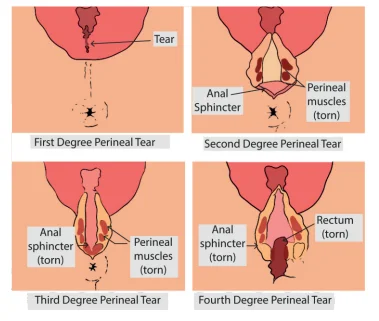Epistomy: Uses, Procedure, Types, Complications, Prevention
Sep 25, 2023
Navigate Quickly
When Is Epistomy Performed?
How Is An Episiotomy Carried Out?
Types Of Episiotomy Incisions
What Are The Different Degrees of Episiotomy?
What Benefits Come With Having an Episiotomy?
What Complications Do Episiotomies Cause?
Prevention of An Episiotomy

An episiotomy, which involves making a small incision between the perineum and the bottom of your vaginal opening, may be performed by your obstetrician during delivery. An episiotomy will increase the size of your vaginal opening, which will make it easier for your baby to pass through. As your baby heads out, your perineum may occasionally naturally tear. This is what are known as perineal tears (or lacerations).
The majority of medical specialists recommend that you tear naturally and do not recommend routine episiotomies. However, the procedure is still used in specific situations.
When Is Epistomy Performed?
Even though episiotomies are uncommon, your doctor may still recommend one if they believe it to be the safest procedure in some circumstances. Examples of these are:
- It is urgent to deliver your baby because it is in distress.
- Because of the prolonged labor, you're fatigued and dehydrated.
- The delivery of your child requires the use of forceps or a vacuum. Use of these tools may need a wider vagina.
- Your child is either breech or has shoulder dystocia, in which case shoulders are impaled in your pelvis.
- It's an obese baby.
- Prolonged Pushing or you can not control pushing.
How Is An Episiotomy Carried Out?
During a vaginal birth, an episiotomy is performed. According to your obstetrician and your health, the precise process could change.
This procedure is typically followed by an episiotomy:
- You'll receive anaesthesia so you won't experience any pain. You lose feeling from your waist down if you've had an epidural. Perhaps no further anaesthesia is required. A local anaesthetic is injected into the perineum if you haven't undergone an epidural.
- The episiotomy incision is made by your healthcare practitioner using episiotomy scissors once your baby has finished crowning (the head is at the vaginal opening and pressing against the perineum).
- The placenta comes after the birth of your child.
- To restore function to the injured tissues and muscles, your doctor will apply absorbable stitches. In addition to determining whether there are complications, they assess the tear's severity.

Types Of Episiotomy Incisions
Incisions typically come in two different forms:
- Median (midline): A vertical incision from the vaginal opening towards the anus is referred to as the median (midline). Despite being a simpler incision, this type of surgery carries a larger risk of rupturing the rectum or anal sphincter.
- Mediolateral: An angled or diagonal incision is called a medial. A 45-degree angle is formed by the incision, which starts at the vaginal opening. The anal sphincter and rectum are less likely to be reached by the incision. Mediolateral incisions have the disadvantages of being more challenging to repair, losing more blood, and being more painful while healing.
Also Read:
What Are The Different Degrees of Episiotomy?
Similar to perineal tears, healthcare professionals categorise the degrees (or levels) of episiotomy in accordance to the severity of the tear. The levels of an episiotomy are:
- First-degree: a small tear that just affects the lining of your vagina.
- Second-degree: A tear that penetrates your vaginal lining to the underlying vaginal tissue. Second-degree episiotomies are generally performed.
- Third-degree: a tear involving your vaginal lining, vaginal tissues, and anal sphincter.
- Fourth-degree: The tear affects the vaginal lining, vaginal tissues, and the anal sphincter.

What Benefits Come With Having an Episiotomy?
In some circumstances, an episiotomy helps in reducing the risk of a poor natural tear. Your episiotomy was performed because it was the most safest procedure for you or your child.
What Complications Do Episiotomies Cause?
Episiotomy complications can include the following:
- Bleeding
- Infection
- Dyspareunia, the painful intercourse
- Injury to the rectum and anal sphincter
- Scarring
- Incontinence of the urine
- Prolonged period of recovery
It's crucial to remember that a spontaneous tear might potentially result in the complications mentioned above
Prevention of An Episiotomy
Since a lot of it is out of your control, it is difficult to prevent perineal tears or an episiotomy. To assist in reducing tears during pregnancy, several healthcare professionals advise extending your perineum.
The likelihood of tearing or needing an episiotomy may be decreased by massaging your perineal tissue (the region between the vaginal entrance and anus) in the weeks before delivery. Although there is conflicting information and some doctors are unsure whether stretching the perineum is effective, it is typically safe.
During the second stage of labour, you can also use a warm compress on your perineum to reduce tearing. This might help in enhancing the tissue's flexibility. To prevent tearing during labour, ask your provider about perineal massage or other methods.
Download the PrepLadder App and get the best neet pg online coaching with world-class video lectures, QBank, Mock Tests and more!
Download PrepLadder's best app for neet pg preparation for Android
Download PrepLadder's best app for neet pg preparation for ios


PrepLadder Medical
Get access to all the essential resources required to ace your medical exam Preparation. Stay updated with the latest news and developments in the medical exam, improve your Medical Exam preparation, and turn your dreams into a reality!
Top searching words
The most popular search terms used by aspirants
- NEET PG OBGYN
- Gynecology OBGYN